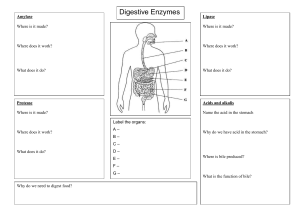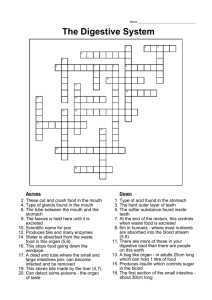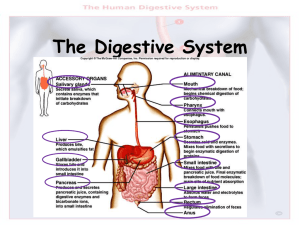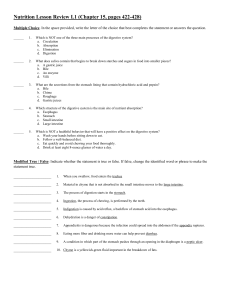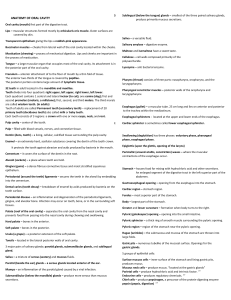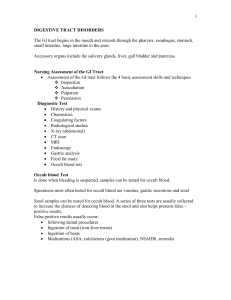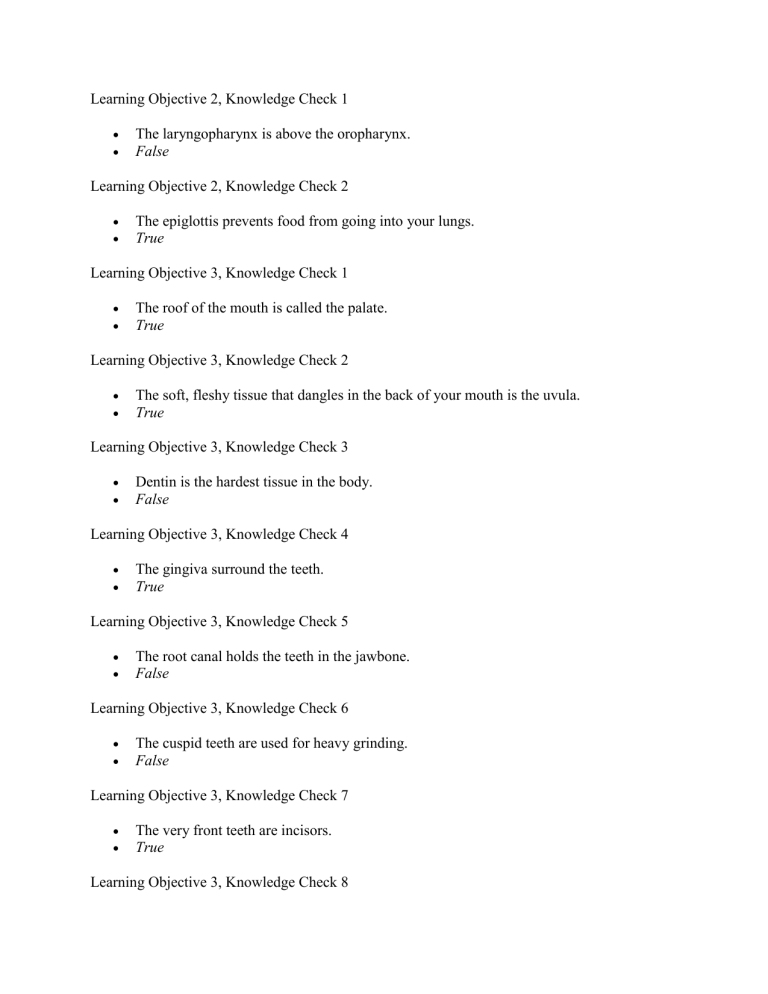
Learning Objective 2, Knowledge Check 1 The laryngopharynx is above the oropharynx. False Learning Objective 2, Knowledge Check 2 The epiglottis prevents food from going into your lungs. True Learning Objective 3, Knowledge Check 1 The roof of the mouth is called the palate. True Learning Objective 3, Knowledge Check 2 The soft, fleshy tissue that dangles in the back of your mouth is the uvula. True Learning Objective 3, Knowledge Check 3 Dentin is the hardest tissue in the body. False Learning Objective 3, Knowledge Check 4 The gingiva surround the teeth. True Learning Objective 3, Knowledge Check 5 The root canal holds the teeth in the jawbone. False Learning Objective 3, Knowledge Check 6 The cuspid teeth are used for heavy grinding. False Learning Objective 3, Knowledge Check 7 The very front teeth are incisors. True Learning Objective 3, Knowledge Check 8 There is one bicuspid tooth on each side of each jaw. False Learning Objective 4, Knowledge Check 1 The parotid glands are located in front of and below the ear. The organ that stores and concentrates bile is the gallbladder. The liver is the organ that creates bile. The enzyme created by salivary glands is amylase. The sublingual glands are located under the tongue. Bile is needed for fat emulsification. Bile from the liver and gallbladder flow to the duodenum via the common bile duct. Learning Objective 5, Knowledge Check 1 Medical term for cold sores herpes labialis Split in the roof of the mouth cleft palate Protrusion of the stomach through the diaphragm into the chest hiatal hernia Disease of the gums and bones surrounding the teeth periodontal Other name for a gastric ulcer peptic Inflammation of the gums gingivitis Medical name for a tooth cavity dental caries Cancerous tumor in the stomach gastric carcinoma Learning Objective 5, Knowledge Check 2 Small Intestine enteritis Crohn's disease volvulus inguinal hernia intussusception ileus Colon irritable bowel syndrome appendicitis diverticulitis polyposis ulcerative colitis Rectum and Anus hemorrhoids anal fistula proctoptosis Accessory Organs hepatitis cholecystitis pancreatitis cholelithiasis cirrhosis Learning Objective 7, Knowledge Check 1 Proctopexy is a type of rectal surgery. True Learning Objective 7, Knowledge Check 2 Palatoplasty can be used to correct a cleft palate. True Learning Objective 7, Knowledge Check 3 Gastric stapling closes off the stomach from the esophagus. False Learning Objective 7, Knowledge Check 4 An ileostomy is required when waste cannot be removed from the rectum or colon. True Learning Objective 7, Knowledge Check 5 A hemorrhoidectomy is surgery only on the anus. False Learning Objective 7, Knowledge Check 6 An appendectomy requires a colostomy while healing. False Learning Objective 7, Knowledge Check 7 An anastomosis is the surgical connection of two organs or vessels. True Learning Objective 7, Knowledge Check 8 A colectomy is removal of the sigmoid colon and rectum. False Learning Objective 7, Knowledge Check 9 Bariatric surgery is a term for a variety of treatments to reduce the size of the stomach. True Learning Objective 7, Knowledge Check 10 A colostomy requires that the patient wear an external bag to collect feces. True
